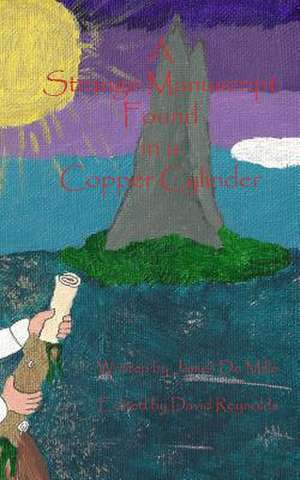A Strange Manuscript Found in a Copper Cylinder
Autor James De Mille Introducere de David Reynolds Note de subsol de David Reynoldsen Limba Engleză Paperback
| Toate formatele și edițiile | Preț | Express |
|---|---|---|
| Paperback (14) | 50.57 lei 3-5 săpt. | |
| CREATESPACE – | 50.57 lei 3-5 săpt. | |
| Mint Editions – 16 noi 2021 | 63.05 lei 3-5 săpt. | |
| CreateSpace Independent Publishing Platform – | 81.20 lei 3-5 săpt. | |
| Les prairies numériques – 16 oct 2020 | 112.27 lei 3-5 săpt. | |
| CREATESPACE – | 119.13 lei 3-5 săpt. | |
| Problematic Press – | 136.26 lei 3-5 săpt. | |
| BROADVIEW PRESS LTD – 30 sep 2011 | 181.21 lei 3-5 săpt. | +45.74 lei 5-11 zile |
| Lector House – 10 iun 2019 | 88.86 lei 6-8 săpt. | |
| Blurb – 8 feb 2019 | 105.32 lei 38-44 zile | |
| Book Jungle – 26 mar 2008 | 129.00 lei 6-8 săpt. | |
| ALPHA EDITION – 19 noi 2024 | 163.04 lei 38-44 zile | |
| CreateSpace Independent Publishing Platform – | 175.02 lei 6-8 săpt. | |
| TREDITION CLASSICS – 31 oct 2011 | 186.33 lei 6-8 săpt. | |
| Patterson Press – 2 noi 2011 | 227.54 lei 38-44 zile | |
| Hardback (1) | 115.88 lei 3-5 săpt. | |
| Mint Editions – 16 noi 2021 | 115.88 lei 3-5 săpt. |
Preț: 136.26 lei
Nou
26.08€ • 27.06$ • 21.80£
Carte disponibilă
Livrare economică 24 februarie-10 martie
Specificații
ISBN-10: 0986902756
Pagini: 360
Dimensiuni: 127 x 203 x 20 mm
Greutate: 0.39 kg
Editura: Problematic Press
Notă biografică
Textul de pe ultima copertă
Drifting on a sailing boat off the Canary Islands, four British gentlemen take turns reading a manuscript that they find inside a copper cylinder discovered floating in the Atlantic Ocean. The manuscript recounts Adam More’s adventures after being lost at sea during an Antarctic voyage in 1844 and his life with the Kosekin, a lost civilization living at the South Pole. The values of the Kosekin are opposed to the civilized norm—they love death, abjection, and poverty. Their society may be well suited to their particular evolution, but it is profoundly disconcerting to the narrator, and it is radically contentious to the Victorian gentlemen who read and debate More’s account.
This Broadview edition of James De Mille’s classic recreates the format of the posthumous 1888 Harper’s Weekly serial, including 18 original illustrations by Gilbert Gaul. The appendices allow the novel to be seen in terms of other satirical and scientific romance, Antarctic exploration, and contemporary geology. The introduction and notes tap into recent scholarship to bring to life De Mille’s genre innovations and his use of Orientalist and colonialist discourses.
